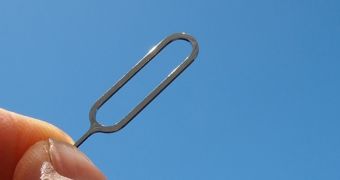Speculation surrounding an upcoming version of the iPhone said to employ Liquidmetal parts has kept everyone’s attention away from a piece of metal shipping with iPhone 3G handsets - the pin for ejecting the iPhone 3G SIM card.
Atakan Peker, the co-inventor of the material, spoke with CultofMac last week revealing that Apple almost certainly has plans to build an antenna inside an upcoming version of the iPhone solely made from a Liquidmetal alloy.
“Let me state that this is very exciting for me,” he said. “I made the first and original alloy formulations… I am a big Mac fan and admire greatly Apple as a company.”
“I have been using Mac exclusively my whole life, both at work and home. It is a pleasant surprise for me to see both get together,” Peker added.
However, according to Peker, there's already some Liquidmetal in the hands of iPhone 3G users out there - the pin for ejecting the iPhone 3G SIM card.
Peker immediately recognized the metal when he opened his iPhone 3G, he told CultofMac.
“That’s my metal,” he said. “I recognized it immediately. Take it from an expert, that’s Liquidmetal.”
Peker co-invented Liquidmetal alloys with engineering professor Bill Johnson, in 1993. At the time, Peker was a graduate student at the California Institute of Technology.
He is now Director of Advanced Materials at Washington State University, after dedicating 13 years of his life to Liquidmetal Technologies.
“It is practically unbendable by hand unless you want to hurt or cut your fingers,” Peker added.
The interviewers claim to have independently confirmed that Apple employed Liquidmetal.
Apple allegedly sourced the pin in question from Liquidmetal Technologies as a test of their manufacturing capabilities.
However, iPhone 3G units sold to the European marked allegedly ship with ordinary steel pins. Asia too, most likely, said Peker.
”They’re not Liquidmetal,” he explained. “They bend like paperclips.”
Apple has recently signed an exclusive agreement with Liquidmetal Technologies for rights to use the super-durable, anti-corrosive materials, with molding properties akin to those of plastic.

 14 DAY TRIAL //
14 DAY TRIAL //